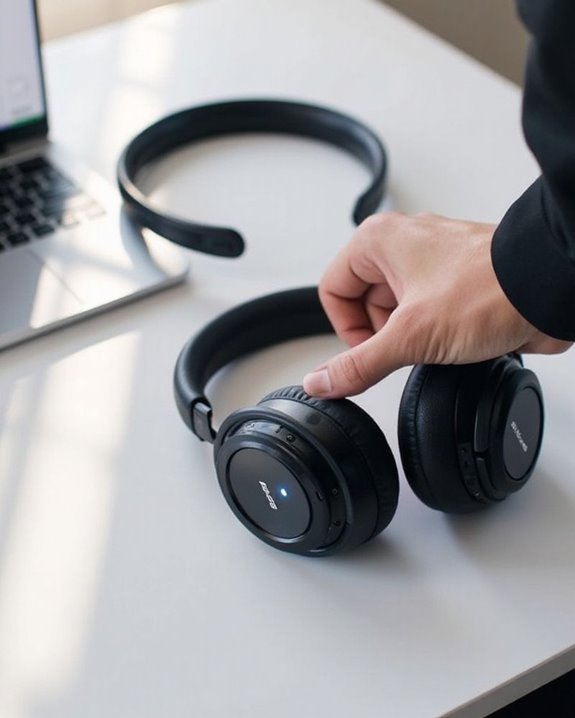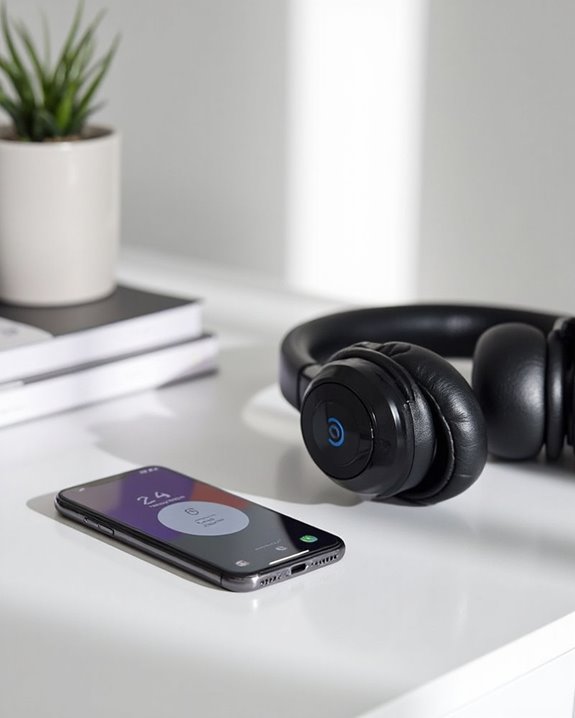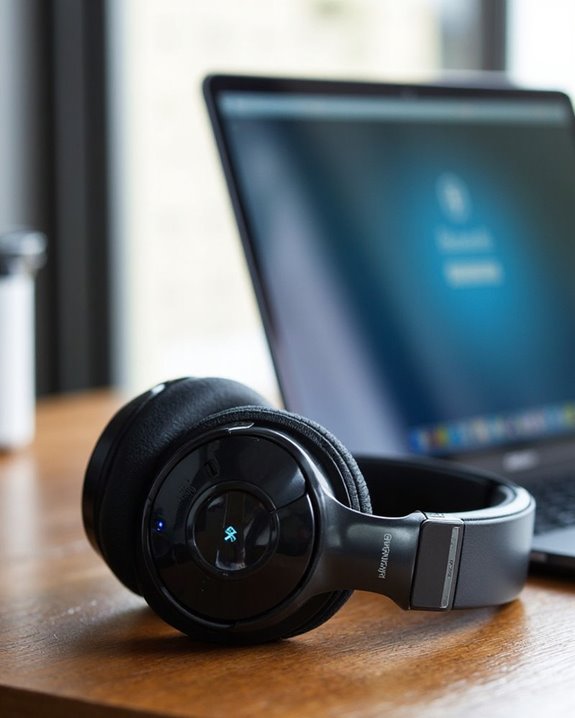Connecting Bluetooth headphones requires simple preparation and execution. First, make sure devices are charged and within 10 meters of each other. Put headphones in pairing mode by holding the power button until indicator lights flash. On smartphones, navigate to Bluetooth settings, enable scanning, and select your headphones from the available devices list. Computers follow similar procedures through system settings. Addressing common issues like interference and battery levels guarantees successful wireless audio enjoyment. The complete connection process offers additional device-specific nuances.
Key Takeaways
- Put headphones in pairing mode by holding the power button for 3-7 seconds until LED indicators flash.
- On smartphones, enable Bluetooth in Settings, scan for devices, and select your headphones from the list.
- For computers, access Bluetooth settings in Windows or Mac System Settings and connect when headphones appear.
- Ensure devices are within 10 meters of each other and minimize interference from other 2.4 GHz devices.
- Check that both devices are adequately charged and updated with the latest software for optimal compatibility.
Understanding Bluetooth Pairing Fundamentals
When two Bluetooth devices connect for the first time, they undergo a process called pairing that establishes a secure relationship between them. This critical security handshake exchanges important information about device capabilities and generates encryption keys for protecting data transmission.
The process unfolds through distinct Pairing Phases:
- Initial exchange of device features and capabilities
- Key generation (using either Legacy pairing or Secure Connections)
- Distribution of transport-specific keys for future connections
The method used during pairing depends on the input/output capabilities of both devices, ranging from the simple “Just Works” method to more secure options like Passkey Entry or Numeric Comparison. After successful pairing, devices may implement Bonding Storage, which saves security keys for quicker reconnection without repeating the full pairing process. Modern Bluetooth versions like Bluetooth 5.4 also enhance security and provide more stable connections up to 33 feet.
Essential Preparation Steps Before Connecting
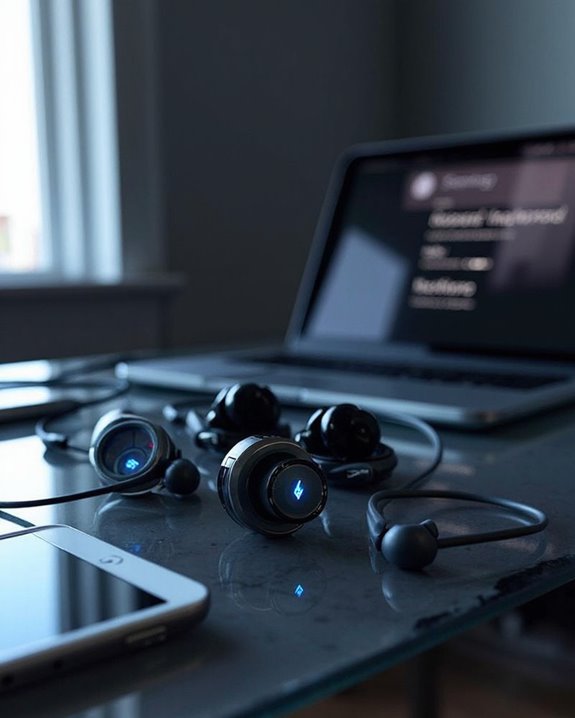
Before attempting to connect Bluetooth headphones to any device, several critical preparation steps guarantee a smooth and successful pairing process. Making sure devices are fully charged is a fundamental aspect of Battery Maintenance, as low power levels frequently cause pairing failures or unstable connections.
Manual Verification involves consulting the headphone documentation for device-specific pairing instructions and troubleshooting guidance that universal methods might not address. These manuals often detail required button combinations and LED indicator patterns specific to each model.
Position devices within 10 meters of each other, minimizing physical barriers that reduce effective range. Additionally, users should eliminate potential wireless interference by turning off nearby devices operating on the 2.4 GHz frequency band, including microwaves and cordless phones. Finally, make sure the parent device has updated software and enabled Bluetooth functionality before initiating the pairing sequence. Utilizing headphones with the latest Bluetooth 5.4 technology can also enhance connection stability and reduce latency during use.
Putting Your Headphones in Pairing Mode
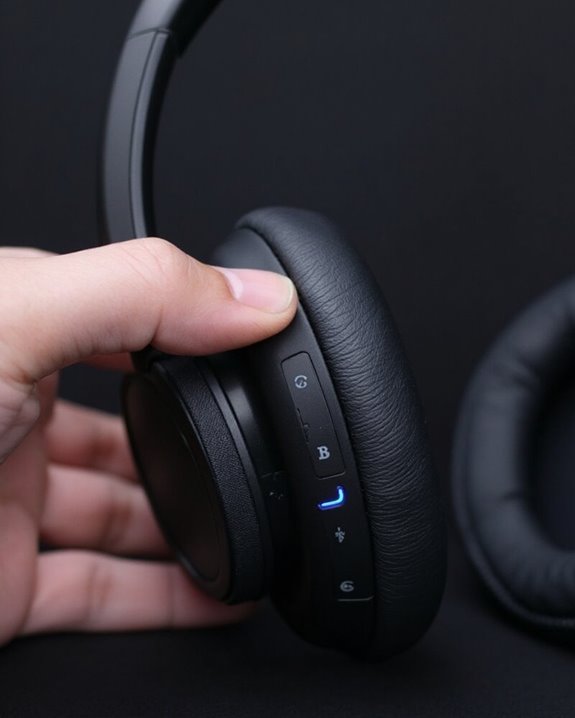
Putting headphones into pairing mode represents the critical step that allows devices to discover and connect with one another. Most models require pressing and holding the power button for 3-7 seconds until LED indicators flash, typically in blue/white or alternating red/blue patterns.
Contrary to common Pairing Myths, the process isn’t uniform across all headphones. Standard Variations exist between manufacturers and even within product lines. True Wireless earbuds often enter pairing mode automatically when removed from their charging case, while others require removing tabs or pressing buttons on each earbud separately.
Voice prompts like “Bluetooth pairing” provide audible confirmation when successful. If no connection occurs within approximately 5 minutes, most headphones automatically exit pairing mode and require restarting the process. Many top wireless earbuds now feature Bluetooth 5.3 or newer technology that enhances stable connectivity during pairing.
Connecting to Ios and Android Smartphones
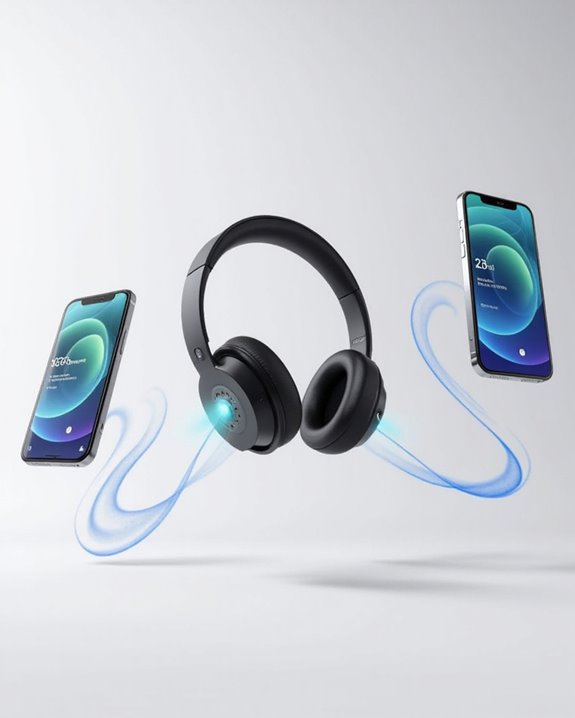
Although the fundamentals remain consistent across platforms, connecting Bluetooth headphones to iOS and Android smartphones involves slight variations in menu navigation and interface elements.
For iOS devices, users navigate to Settings, select Bluetooth, and toggle it on. iOS Features include automatic scanning for nearby devices without requiring a manual scan button. Once headphones appear in the available devices list, users simply tap to connect.
With Android Customization options, the path may differ slightly between manufacturers. Users typically open Settings, tap “Connections” or “Connected Devices,” enable Bluetooth, then manually initiate a scan. After the headphones appear in the discovered devices list, selecting them completes the pairing process.
If connection issues occur, users should make sure both devices have Bluetooth enabled, restart devices if necessary, and verify they’re within proper range of each other.
Pairing With Windows and Mac Computers

Connecting Bluetooth headphones to computers requires several specific steps that differ between Windows and Mac operating systems. Each platform offers robust OS integration features to streamline the pairing process while maintaining pairing security protocols.
For Windows, users access Bluetooth settings through the Settings menu, activate pairing mode on their headphones, and select them from available devices. Windows’ Bluetooth troubleshooter can resolve common connection issues when necessary.
Mac users navigate to System Settings, activate the headphones’ pairing mode, and click “Connect” when the device appears. For ideal performance, users should verify the proper audio output selection in system preferences.
Both systems may require driver updates or device restarts to resolve connectivity issues. Keeping devices within recommended range and minimizing interference from other wireless devices guarantees stable connections.
Common Connection Problems and Solutions
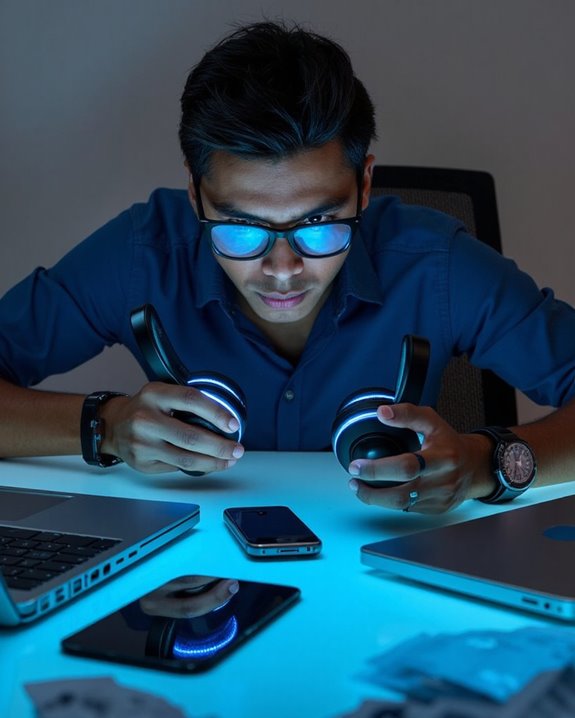
When users experience difficulties with Bluetooth headphones, several common issues can typically be identified and resolved through systematic troubleshooting. Low battery levels frequently prevent successful pairing or cause intermittent disconnections, making Battery Troubleshooting essential for maintaining reliable performance.
Connection problems often stem from incorrect pairing procedures or device incompatibility. Ensuring headphones are properly in pairing mode and testing with multiple devices can isolate the source of the issue.
Interference Management becomes vital when dealing with signal disruptions. Physical obstacles, distance limitations (typically 10 meters), and competing wireless signals can all degrade connection quality. Moving devices closer together and minimizing environmental interference from Wi-Fi routers or microwaves greatly improves stability.
For headphones that pair but produce no sound, checking audio output settings on the connected device usually resolves the problem.
Frequently Asked Questions
Can I Connect My Bluetooth Headphones to a Smart TV?
Most modern smart TVs offer Bluetooth capability, allowing headphone connections. Users should check their TV compatibility specifications and consider potential audio latency issues when watching video content through wireless headphones.
How Do I Switch Between Multiple Paired Devices Quickly?
Users can switch between paired devices using dedicated buttons on headphones, companion apps, or device management settings. Many headphones with multipoint technology automatically prioritize incoming calls, offering seamless device switching without manual reconnection.
Why Do My Headphones Disconnect During Phone Calls?
Ironically, the devices meant to connect us are notorious for disconnections. Headphones may drop during calls due to signal interference, exceeded Bluetooth range, low battery, or device incompatibility—all factors affecting call stability.
Can Bluetooth Headphones Connect to Gaming Consoles?
Bluetooth headphones can connect to gaming consoles with varying compatibility. Nintendo Switch supports direct console pairing, while PlayStation and Xbox require adapters or workarounds. Users should consider gaming latency when selecting headsets for best performance.
How Much Does Bluetooth Connectivity Affect Headphone Battery Life?
Bluetooth connectivity has minimal impact on headphone battery life with proper Battery Optimization. The primary Drain Factors are volume levels, noise cancellation features, and signal strength rather than the Bluetooth connection itself.


